Standard [CURRENT]
ASTM E 3157:2025
Standard Guide for Understanding and Using Information Related to Installation of Firestop Systems
- Publication date
- 2025
- Original language
- English
- Pages
- 22
- Publication date
- 2025
- Original language
- English
- Pages
- 22
- DOI
- https://dx.doi.org/10.1520/E3157-25
Product information on this site:
Quick delivery via download or delivery service
Buy securely with a credit card or pay upon receipt of invoice
All transactions are encrypted
Short description
1.1 This guide is a compendium of information related to installing firestop systems in fire-separating elements . This guide is intended to be used to increase industry knowledge of national and international testing requirements, code prerequisites, and other supplemental tests that may be specified, which can affect the installation and performance of firestop systems . 1.2 This guide relates to the use of firestop systems tested, or evaluated, to Test Method E814 and other test methods addressing the same specific subject matter, such as CAN/ULC-S115; EN 1366-3; IMO Resolution MSC.307(88), FTP Code; IEEE 634; ISO 10295-1; UL 1479; etc. 1.3 This guide also addresses the use of firestop systems tested or evaluated to Test Methods E119 or other test methods that use a firestop system as a component of a typically larger test assembly, such as AS 1530.4; BS 476-21; BS 476; 3 CAN/ULC-S101; ISO 834; 4 NFPA 251; UL 263; etc. 1.4 This guide discusses the installation of firestop systems in membrane penetrations and through penetrations . The installation is typically performed by a firestop contractor (also known as a firestop installer or an installer). However, the quality of the installation is based on the information provided to the firestop contractor as well as the expertise and competence of the firestop contractor. A lack of information in the test report, listing , manufacturer's instructions , or project documents can be the cause of a deficient installation. 1.5 The term " firestop system " refers to and includes both a membrane-penetration firestop system and through-penetration firestop system . 1.6 Information in this guide is applicable to firestop systems that accommodate single or multiple penetrating items . 1.7 This guide does not address the design aspects of locating and defining the dimensions of an opening ; or the method to create the opening ; or the inspection of the penetrating item prior to firestop material installation. However, locating and defining the dimensions of an opening and the method to create the opening are critical to a firestop system 's installation. 1.8 This guide does not address all the test methods needed to address proper performance of all firestop systems or firestop materials . Note 1: For example, IEEE 848 provides information on the ampacity derating of cables that are protected by firestop systems using IEEE 835 as baseline information. 1.9 This guide does not address all the test methods needed to address proper performance of firestop systems in all installations. For a specific application of a firestop system one or more of the following are consulted when available: 1.9.1 The firestop system 's test report or listing ; 1.9.2 The manufacturer's instructions when they are not in conflict with the firestop system 's test report or listing ; or 1.9.3 A judgment with justifiable technical rationale prepared based on a firestop system 's test report or listing . 1.10 The values stated in inch-pound units are to be regarded as standard. The values given in parentheses are mathematical conversions to SI units that are provided for information only and are not considered standard. 1.11 The text of this standard references notes and footnotes which provide explanatory material. These notes and footnotes (excluding those in tables and figures) shall not be considered as requirements of the standard. 1.12 This guide offers an organized collection of information or a series of options and does not recommend a specific course of action. This document cannot replace education or experience and should be used in conjunction with professional judgment. Not all aspects of this guide may be applicable in all circumstances. This ASTM standard is not intended to represent or replace the standard of care by which the adequacy of a given professional service must be judged, nor should this document be applied without consideration of a project's many unique aspects. The word "Standard" in the title of this document means only that the document has been approved through the ASTM consensus process. 1.13 Fire standards, other than ASTM standards, are referenced in this document. The following caveat applies to all fire standards referenced in this guide. Fire testing is inherently hazardous. Adequate safeguards for personnel and property shall be employed in conducting these tests. 1.14 This standard does not purport to address all of the safety concerns, if any, associated with its use. It is the responsibility of the user of this standard to establish appropriate safety, health, and environmental practices and determine the applicability of regulatory limitations prior to use. 1.15 This international standard was developed in accordance with internationally recognized principles on standardization established in the Decision on Principles for the Development of International Standards, Guides and Recommendations issued by the World Trade Organization Technical Barriers to Trade (TBT) Committee.
ICS
13.220.50,
29.060.20
DOI
https://dx.doi.org/10.1520/E3157-25
Also available in
Loading recommended items...
Loading recommended items...
Loading recommended items...
Loading recommended items...

